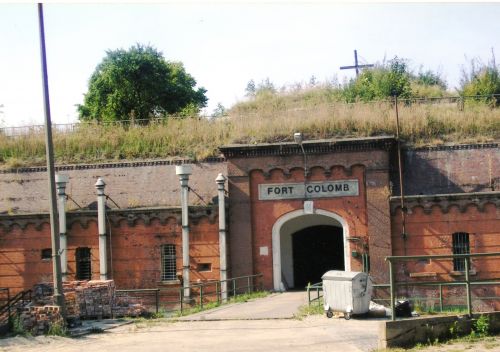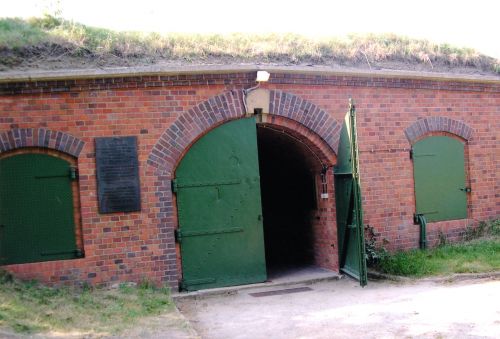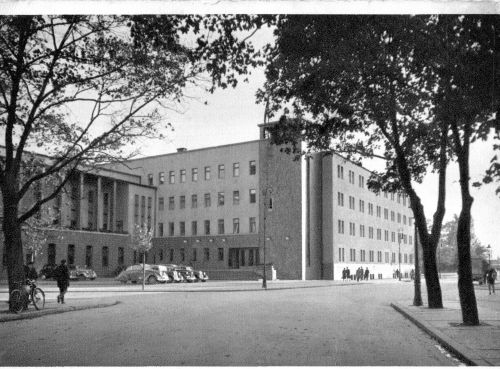Posen Fort VII

Poznan 2005 - Entrance to Fort VII (Chris Webb Private Archive)
The Nazi extermination policy towards the Polish nation began almost immediately after the German invasion in September 1939. Genocidal plans, developed for a long time before the outbreak of the Second World War by the rulers of the Third Reich, were implemented with the help of all available methods and means, among which the most important various types of camps played a prominent role. Independently from their name , that is whether they were called extermination camps or concentration camps and penal camps or forced labour camps they had one primary goal. This goal was to destroy the Polish population, among others by confining prisoners to the most inhuman and bestial tortures , carrying out mass executions, as well as confining people in appalling sanitary and health conditions.
On the territory of Poland during the occupation there were over 1,800 camps of various types. Among them were huge 'death factories' such as Auschwitz, Lublin, or Treblinka, and smaller ones that did not consume as many victims, but which were not inferior in cruelty and methods to those, compared to those that have become synonymous with Nazi crimes. These included the Transit Camp and at the same time a Penal-Investigation Camp in the so-called Fort VII, located in the suburbs of Poznan, or as it was called during the occupation as Posen.
The territory of Greater Poland (Wielkopolska) including Posen was incorporated into the Third Reich and was given the name 'Warthegau.' A similar fate befell other parts of Poland, such as Pomerania and Silesia. From October 1939, Greater Poland found itself under the control of Gauleiter Arthur Greiser, who was appointed by Hitler the governor of these lands. His reign went down bloodily in the history of the Greater Poland region. One of the most ruthless and cruelest of Nazi executioners - Greiser was particularly zealous in executing his extermination plans against the Poles and Jews. He assured Hitler that the Polish language would never again be heard and that the territories of the Warthegau would forever be native German territory.
As a consequence unprecedented terror was unleashed in Greater Poland against the Polish population. Deportations started. There was a brutal expulsion of people from their homeland. Discriminatory regulations and decrees against Poles were issued. Various camps were, concurrently, established whose purpose was the physical extermination of the so-called 'Polish element.'
In October 1939, one of the first transit camps was established. At the same time, a Penal and Investigation camp -prison in Fort VII in Posen was also established. Arthur Greiser personally initiated the establishment of these camps. The camp was immediately set up to incarcerate Poles, above all, former Greater Poland insurgents, members of the intelligentsia, and all those suspected on anti-German activity in the inter-war years. There were also Polish political and social activists, soldiers, Polish Army officers, and young people incarcerated there. A large group of prisoners included professors of the University of Posen, as well as teachers from junior high schools and schools.
Poles were brought to the dungeons of Fort VII from Warthegau, as well as from Silesia, Pomerania and even Warsaw. However, the largest number of prisoners Poles from Greater Poland. Numerous prisoners of other nationalities passed through Fort VII, among them English, French, Yugoslav German anti-fascists, citizens of the Soviet Union. The Nazis never hesitated to violate international law. At Fort VII, the Nazis imprisoned Prisoners of War, who were therefore protected by the Hague and Geneva Conventions.
The choice of Fort VII for the camp was not co-incidental. The Fort located on the western outskirts of Posen was built at the end of the last century. Its buildings consisted of damp, dark, and gloomy dungeons, located underground and above-ground shelters made of brick, with a thick layer of earth superimposed on them. The conditions of the buildings and the underground dungeons were terrible. There was no sunlight or fresh air. Foul-smelling water seeped through the walls. There was an indescribable stench and mustiness. The rooms were small, without windows. There was no sanitary facilities of any kind.
Fort VII was surrounded by barbed-wire entanglements and a deep and wide moat. The central entrance to the camp was a huge steel gate. In most cases, to cross the gate was a death sentence. The SS exercised power in Fort VII, of which the following were reminders. Two ominous letters above the entrance to the camp commandant's office. This building adjoined the main entrance of Fort VII. Immediately after crossing the gate, the new arrivals were 'christened' in accordance with Nazi custom, which was applied as a rule in all German execution camps. The terrified, dazed people were beaten with clubs, whips and rifle butts. They were forced to run the distance between them from the prison buildings. Then amidst the incessant beatings, they ran down the stairs into the depths of the dungeons. The cells were devoid of any furnishings in the forms of beds or stools. The prisoners slept on the concrete or stone floor, in damp and musty conditions. There were also no blankets to cover themselves with, no pillows etc.
The camp initially was planned to house approximately 1,000 people, usually housed a much greater number. The situation was made worse by the fact that the Nazis placed several times more people in the small cells than originally planned. Under these conditions, only some of the prisoners slept in individual cells lying down. Others had to stand, unable to lie down for lack of space. After a few hours, there was a change and those who had been lying down had to survive the rest of the night in a standing position. Such alternative sleeping was a normal occurrence in Fort VII. It should be added that the vents were infested with vermin, and after a relatively short period of stay, people were infested with lice.
The conditions were ripe for the development of all kinds of infectious diseases that decimated the unfortunate victims of Fort VII. People also contracted tuberculosis in the dark, damp cellars. As in other German camps, medical care at Fort VII was the bare minimum. Deprived of medicines, people more and more vulnerable to illness. In the carefully devised system of extermination prisoners were deprived of food, that would have contained the calories that they needed to survive.
The prison menu consisted of bitter black grain coffee, a piece of moldy bread, and a colorless soup without any fat.This food has to last the prisoner for a whole day. There were times when the Nazis allowed prisoners families to send parcels for those arrested. However, the contents of the packages became the property of the prison guards who took and appropriated all the most valuable food items.If any parcel reached the addressee, it was deprived of all what was necessary to sustain his physical strength.
A certain part of the cellar rooms, namely the smallest cells, were designated by the Nazis for the so-called penal cells. All those who, for whatever reason, offended the camp staff were placed there. In fact, they often locked up prisoners in these prison cells for no reason at all, as part of a continuous process of extermination. Placement in these punishment cells was an additional torment for the prisoners, who had already been horribly abused. These cells were so small that one could only sit in a half-lying position or squat. Straightening up was out of the question. All of those who found themselves in this part of the dungeons were not served meals. They were starved. A stay in a punishment cell could last up to ten days. This of course, meant a slow death from hunger and exhaustion.
The camp garrison, consisted of seasoned SS thugs, did their utmost to ensure that Fort VII would continue to devour new victims every day. The prisoners were therefore subjected to various forms of torture and harassment. They were forced to make superhuman efforts and beaten until death. During the never -ending roll call, which took place day and night, the prisoners were forced to stand.Depending on the season and weather, prisoners were killed with a pistol or a rifle, a club, a crowbar, and fists. Giant police dogs were set upon and often bit emaciated prisoners. The guards scattered along the underground corridors beat the prisoners who ran out at their beck and call in a cruel manner. Many of the prisoners had already died in the dungeons before they were taken out to roll call. Hitler's guards ensured that each of the murdered victims even after death, became the cause of further torments and suffering for their comrades still alive. For they stood at the roll call for so long until they were found and bodies of the murdered were found and brought to them, for whom even after death, the Nazi machine found a place in the ranks.
The Nazis were particularly cruel to the participants in the Wielkopolska Uprising that took place during 1918-19. The Nazis even invented a special type of torture, which they called the 'Greater Poland Uprising.' It consisted of performing countless squats and the so-called 'frogs' falling down and getting up on command for hours. After such exercises many people died on the spot. In every camp, Hitler's henchmen ingenuity manifested itself in the form of some special torture not known elsewhere. This was also the case at Fort VII.
One of the small cells, unlike the others, had a round shape. A huge hook was driven into its ceiling, on which the prisoner was hung by the legs. The prisoner hung in this position was made to swing causing him to hit his head harder and harder into the wall. Blow after blow, the skull cracked and the tormented man hung dead. In Nazi jargon this cell was called 'Die Glocke' (The Bell). The heart of 'this bell' was the human body.
A favorite pastime of the Nazi guards was also another form of torture. In the dark corridors of the dungeons, prisoners were forced to stand a few dozen centimeters from the wall that they faced. Prisoners standing like this were forbidden to make the slightest move, not even to look at themselves. A Nazi guard suddenly came up to his intended victim, an unsuspecting prisoner, and with all his might with his fist on the back of the head, smashed the prisoners face or head against the wall. This very often ended in the prisoners death. After this kind of torture, the corridor walls were splattered with blood and brains. Other prisoners were then forced to wash the walls, so that no trace of the massacre remained on them.
Depending on the season, various types of torture were also invented in relation to the unfortunate people. In the winter, for example, one of the guards favourite games was the so-called 'Trip to the Carpathians.' It involved the pouring of water over one of the numerous hills within the Fort VII's grounds in freezing weather. When the hill was covered in ice, prisoners were thrown down from its top with a blow from a fist, or a kick. As the prisoners fell, they broke their arms and legs in the frost, smashed their heads, and suffered other injuries. These macabre scenes were accompanied by the loud laughter and cheers from the Nazi observers.
Women were also imprisoned in Fort VII. They were treated just as cruelly as the men. They were beaten and tortured. They were forced to do the hardest and most degrading work. Female prisoners were ordered to remove the waste from the sewage pits with their bare hands. Then they were drenched with this waste or they were ordered to spill it on their fellow women prisoners. Younger and more pretty female prisoners were particularly harassed. The Nazi camp guards raped them.

Poznan 2005 - Gas Chamber Building (Chris Webb Private Archive)
The Nazis used a gas chamber in Fort VII, to murder the patients from the mental hospital in Owinska. Henryk Maliczak, who had been arrested in Koscian in November 1939, was later transferred to Fort VII in Posen, where he was incarcerated in a cell designated SK (Sonderkommando) and he witnessed them being gassed: Various methods of gassing was used in Fort VII. The first method was a test gassing using the agent Zyklon-B, the method used at Auschwitz. Two weeks later a second test was carried out using bottled carbon monoxide gas, during 1939. In 1940, a gas van was used.
We were initially employed in transporting and burying the corpses of the mentally ill. The first victims came from the psychiatric hospital in Owinska. They were transported by truck to Fort VII and gassed in a bunker, the door and window had been hermetically sealed. I saw how members of the camp staff and others, dressed in SS uniforms, observed the gassing through a window in the door of a bunker. A special group of approximately ten SS men, not Fort VII personnel, transported the mentally ill from the hospital in Owinska and gassed them. This group was commanded by an SS man named Lange.
The gassing occurred in this way two or three times over a period of several days. The victims were calm. I supposed they had been tranquilized with injections. Our role in this activity consisted of carrying the corpses of the victims to trucks that transported them to forests near the town of Oborniki Slaskie. Here we threw the corpses into previously dug pits. We learned from members of Lange's Kommando that the victims came from Owinska and were mentally ill. They tried to put us at ease, saying that such people had to be eliminated.
Fort VII also served as the central Gestapo prison in Wielkopolska. The Gestapo incarcerated people arrested by the police. There were those who were waiting to be sent to other camps, and those who were sentenced to death. Every day cars left Fort VII to take people for interrogation to the Gestapo Headquarters in Posen. The Gestapo headquarters was located in the former Soldiers Home. Both from Gestapo Headquarters and from Fort VII, the victims who had been brutally tortured during their interrogations were transported to various camps and prisons in other cities.

Posen - Gestapo Headquarters During the Occupation Postcard (Chris Webb Private Archive)
Those who did not survive the interrogations and those that were murdered in Fort VII, were buried near Posen in the Przezmirow forest. From time to time, special teams of prisoners excavated the corpses and burned them to cover the traces of the crimes.Others tortured in the dungeons of Fort VII, were also taken to other forests near Posen, and buried in mass graves.
The Nazis often carried out mass executions in the forests near Posen. They were held, among others, near the village of Debienko. At the turn of 1939-1940, in the nearby forests, Gestapo and SS-men murdered more than 1,700 prisoners from Fort VII, including more than 100 women. In the same period, more than 2,500 prisoners were shot in the forests near Dabrowka and Paledza. Mass murders were also carried out at Lake Rusalka. In the groves surrounding the lake, there is a grave of approximately 2,000 people, who were once incarcerated in Fort VII.In the long list of locations where the mass executions of Fort VII prisoners were carried out, there are other locations such as the forests belonging to Wypalanki forestry near Posen, the village of Zakrzewo and many others.
Mass crimes were also committed within the confines of Fort VII itself. The area there, crossed by embankments, moats, alleyways and places hidden from prying eyes were suitable for murdering people. The Nazis carried out large or small scale executions almost every day. Before their execution prisoners were kept in a special bunker near the so-called 'Death Wall,' a brick wall under which the executions took place. Prisoners were also murdered by freezing them to death in bunker number 57, or immersing them alternately in hot and icy water in bunker number 58.There were more ways of killing people in the camp. Exhausted and emaciated prisoners were ordered to run up the sleep slopes of the fortress, forcing them to carry heavy loads beyond their strength. Usually many people died during these murderous exercises.
The SS Garrison who ruled over Fort VII consisted of male and female units. The personnel who served in Fort VII were carefully selected. In principle only those who were faithful followers of the genocidal doctrine of the National Socialist Party were employed. During the four years that Fort VII was in existence, the commandants changed frequently. This frequent rotation was intended to 'strengthen' the management staff with newer and better trained torturers in the craft of murdering people. Each successive commandant was responsible for the deaths of thousands of people. Among those who served as commandants, the first was Herbert Lange, who went on to command the death camp at Chelmno, Mollendorf, Wagner and Werner.
In April 1943, the gradual liquidation of the camp began, transferring some prisoners to the camp at Zabikow near Posen. The last prisoners left Fort VII, in the spring of 1944. In total approximately 40,000 prisoners passed through Fort VII. Most of them were murdered by the Nazis in Fort VII itself or in nearby forests. The rest were taken to other camps.
Sources
Fort VII W Poznaniu Wydawnictwo Sport i Turystyka, Warszawa, 1969
Chris Webb and Artur Hojan, The Chelmno Death Camp, ibidem-verlag, Stuttgart 2019
Cameron Munro - T4 Association - Berlin
Wiener Library London
Photographs: Chris Webb Private Archive
Postcard - Chris Webb Private Archive
Translation by S.Straus
© Holocaust Historical Society May 8, 2023

